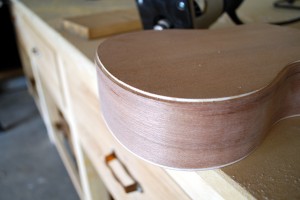I am approaching the halfway point of my week-long vacation, so I decided to finally get going on a few guitar-building projects.
The adventures began on Monday, when I ventured down to Denver to a place called Aspenleaf Millworks to get some of the guitar bodies that I had purchased resawn. Â For those unfamiliar: the guitar bodies that I purchased were 3 1/8″ thick. Â Les Paul bodies are 1 3/4″, so to maximize this expensive old-growth stock I wanted to find a place to cut these 14″ wide slabs along their thickness. Â This would yield me the Les Paul body stock that I wanted and an extra piece to use in a future project.
I’m really grateful for Shane at Aspenleaf Millwork… I had called 15 different places to get someone to resaw this wood for me, since I lack a band saw and thickness planer or sander to accomodate this size of a blank. Â Everywhere else either didn’t have the capacity to do it, wouldn’t do wood that wasn’t theirs (what?) or wasn’t interested in helping me for such a small project. Â Shane not only helped me, but went above and beyond to do the job right at a very reasonable cost. Â I know where I’m going if I ever need this type of work done again. Â For anyone that needs custom molding or millwork done, give Shane a call and you won’t be sorry.
That project is going to kick off in earnest later on this week. Â I spent today getting the first steps of my acoustic project off the ground. Â The first step was building a workboard and getting the neck and tailblock glued into position. Â It was my first experience working with hide glue (it sets up fast!) but I was able to get the pieces in the right location and clamped up. Â We’ll know if I was successful tomorrow when I unclamp things and see if it all stays together. Â I also realized why the professionals seem to have a form that they place their bent sides into, then use screwed cauls to apply pressure to the sides and to hold the blocks in place while gluing occurs. Â The hardest part of the process was fighting against the tension of the bent sides to position and anchor the tailblock in time to glue it.
I used a combination of spring clamps and cam clamps (three on each block) to apply even pressure while the glue dries. Â With any sort of luck everything holds together when the clamps come off and I can move to applying the kerfing strips to the inside of the edges.




